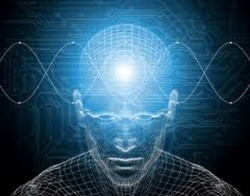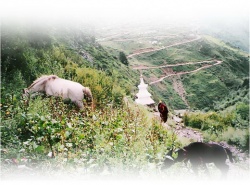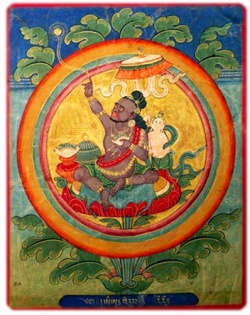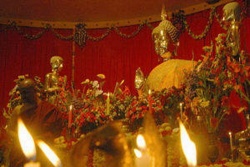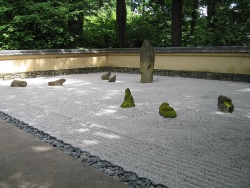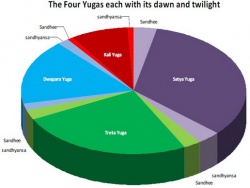Tibetan Cosmology and Modern Science
Tibetan Buddhism is based on a tradition of logical analysis expounded by the great Indian logicians Dignaga (5th century) and Dharmakirti (7th century).
An often-repeated quote from the Buddha advises one to test the truth of an idea or a statement as a goldsmith tests the purity of gold - through reasoned examination and direct experimentation.
Any concept or idea (or even historical religious text) which is found to be illogical or directly contradicts observations of the natural world must be discarded (or regarded as strictly symbolic).
Therefore there is no conflict between science and religion in this tradition - scientific observations always trump historical documents in terms of explanations of the observed world.
For example, the Dalai Lama writes that
if scientific analysis were conclusively to demonstrate certain claims in Buddhism to be false, then we must accept the findings of science and abandon those claims (2005: 3).
However, the observed world is also considered to be only "conventional truth" not absolute truth, so one can also question whether or not scientific explanations are also only conventional (albeit rigorously rested, internally consistent, and highly predictive) explanations of reality.
He continues that
spirituality must be tempered by the insights and discoveries of science. If as spiritual practitioners we ignore the discoveries of science, our practice is also impoverished, as this mind-set can lead to fundamentalism. this is one of the reasons I encourage by Buddhist colleagues to undertake the study of science, so that its insights can be integrated into the Buddhist world view (2005: 13)
Therefore the Dalai Lama considers science to be an essential part of monks' education, and since an early age himself was fascinated with the natural world. How has he reconciled science and the ancient cosmological models in his own mind? Read for yourself:
When I was a child experimenting with the telescope belonging to the 13th Dalai Lama, I had a vivid experience of the power of inference based on empirical observation [looking at the moon].... to my surprise, I saw what looked like shadows. I was so excited that I insisted my two tutors come and peer through the telescope.
I argued that the presence of shadows on the moon was proof that the moon was lit by the sun's light in the same way as the earth. They looked puzzled but agreed.... (2005: 31-2)
[[[Abhidharma]] cosmology] gives very exact measurements of the distance from the earth to the moon and sun and the stars, as well as the size of the sun and moon. The problem is, these measurements are wrong from the modern scientific point of view. For example, the sun is only bigger than the moon by a tiny fraction, and they are the same distance from the earth. These measurements are just crazy (2004: 97)
My own view is that Buddhism must abandon many aspects of the Abhidharma cosmology (2005: 80).
It may seem to be contradictory to continue to teach a cosmology that is known to be scientifically wrong. However, it must be understood that there may be symbolic reasons to continue to teach a philosophy or model, such as its use as a meditational guide.
Alexander Berzin explains that the Abhidharma and Kalachakra cosmologies are "valid for a different purpose, and in neither case is that purpose navigating a space ship" (1997:41).
For example, the Meru-centered cosmology is often compared to the human body, with the spine acting in the role of the central mountain, the four continents symbolizing our arms and legs, and the sun and moon as our eyes.
Meditating on these models of the universe allows one to contemplate the connection between our bodies and the greater universe.
A more modern analogy might be Carl Sagan's often-quoted mantra "We are star stuff" - the very atoms which make up the human body were created inside the nuclear furnaces of previous generations of stars.
Setting aside philosophical considerations, the basic tenets of Tibetan cosmologies, especially the Kalachakra system, have a number of interesting parallels to modern science.
For example, time is considered to be relative and not an absolute quantity.
As described in the section on Cosmological models, the traditional Tibetan universe is cyclical and has something akin to "Big Bangs" and "Big Crunches".
In some modern cosmological models, the universe arises from quantum fluctuations of the vacuum.
The Dalai Lama has expressed interest in the parallels between the space particles of the Kalachakra cosmology and the quantum vacuum of modern cosmology.
Just as inflationary models seem to predict "eternal inflation" (a continued process of new inflationary 'pocket universes' coming into being and possibly being destroyed later), Tibetan Buddhist cosmologies contain a continued cycle of new universes coming into being and old ones passing away.
Finally, the Pali and Indian Buddhist literature list a number of questions which Buddha did not directly answer. Among those are several which are cosmological:
Are the self and the universe eternal?
Are the self and the universe transient?
Are the self and the universe both eternal and transient?
Are the self and the universe neither eternal nor transient?
Do the self and the universe have a beginning?
Do the self and the universe have no beginning?
Do the self and the universe both eternal and transient?
Do the self and the universe neither eternal nor transient?
Reasons for his refusal are varied. Some state that since the answers to these questions do not lead to enlightenment, they were irrelevant. In another view, argued by the important philosopher Nagarjuna,
if one pondered these questions, it might reinforce the erroneous notion that things have an intrinsic, self-contained existence, rather than being "empty" (i.e. existing only in dependence on their proper causes and conditions).
Interested readers should consult the following:
Berzin, Alexander (1997) Taking the Kalachakra Initiation. Ithaca, NY: Snow Lion Press.
Dalai Lama (2005) The Universe in a Single Atom. NY: Morgan Road Books.
Ricard, Matthieu and Trinh Xuan Thuan (2001) The Quantum and the Lotus. NY: Crown Publishers.
Wallace, B. Alan, ed. (2003) Buddhism and Science: Breaking New Ground. NY: Columbia University Press.
Zajonc, Arthur, ed. (2004) The New Physics and Cosmology: Dialogues with the Dalai Lama. NY: Oxford University Press.
